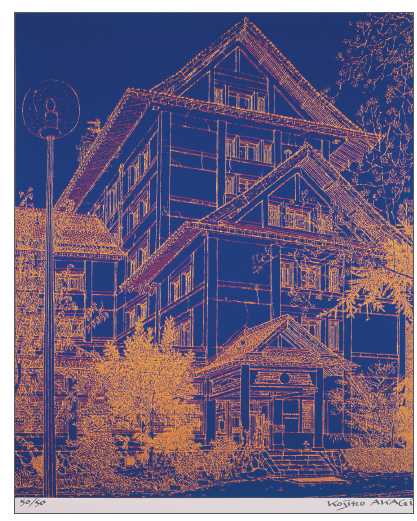La Maison du Japon dans la Cité universitaire / Japan House in the University City campus / パリ大学都市日本館
Dublin Core
Title
La Maison du Japon dans la Cité universitaire / Japan House in the University City campus / パリ大学都市日本館
Subject
Maison du Japon, Cité universitaire
Description
Après la rue Mouffetard, en descendant plus au sud, on trouve la manufacture des Gobelins. En poursuivant encore plus au sud, on arrive Place d’Italie où l’on voit un bâtiment étrange conçu par Kenzo TANGE. Derrière lui se trouve le quartier chinois de Paris qui s’étend jusqu’à la banlieue. A ce niveau on trouve la Cité universitaire qui a été ouverte en 1925. Sur un terrain de 40 hectares, 37 bâtiments ont été construits grâce aux dons de différents pays ou fondations, afin d’offrir des logements aux étudiants du monde entier venus étudier à Paris. Encore aujourd’hui, la Cité fonctionne selon ce système ingénieux : la gestion de chaque bâtiment est confiée au pays correspondant ou à des fondations, tandis que l’administration générale est assurée par la France, qui a offert le terrain. C’est une pratique bienveillante en faveur des étudiants venus de pays étrangers. Inaugurée le 10 mai 1929, la maison du Japon a été construite grâce aux dons personnels de Jirohachi SATSUMA. C’est pour cette raison qu’on l’appelle aussi la maison de Satsuma. A l’époque, le Japon se concentrait sur le renforcement national et n’envisageait pas de développer des échanges culturels ou d’apporter une aide internationale. Au début, les fonds ont été entièrement fournis par Jirohachi SATSUMA, mais lorsqu’e celui-ci a rencontré des difficultés, le Japon a pris la relève, faisant ainsi de ce bâtiment le premier exemple d’une propriété gérée et administrée à l’extérieur du Japon. Aujourd’hui, la maison est gérée par le Japon et financée par les impôts japonais. Tous les deux ans, le directeur est nommé par le Ministère de l’Éducation, de la Culture, des Sports, de la Recherche et de la Technologie. De nombreux professeurs universitaires parlent toujours avec nostalgie de leur séjour dans cette maison, car le loyer peu onéreux leur a permis de séjourner à Paris. Conçue par un architecte français avec l’idée de lui donner un côté japonais, le pavillon a l’apparence extérieure typique d’un ryokan, une auberge japonaise. Pourtant il est en béton, mais peu importe...
If you go further down the Rue Mouffetard to the south, you’ll find a Gobelins tapestry factory, an Italian factory further south and an unusual building designed by Kenzo Tange. Behind them all is Chinatown spreading into the suburbs. Next to Chinatown is the Cité internationale Universitaire de Paris which opened in 1925.In the 40 hectares area, 37 buildings were built using funds donated by the government of different countries and consortiums. They are run as boarding facilities for foreign students who come to Paris from all over the world. Still today,
the individual buildings are operated and funded by each government and foundation and the entire management is performed under the auspices of France, who supplied the land, which is a sophisticated arrangement. It is, however, beneficial for overseas students.The Maison du Japon was opened on May 10th 1929. Jirohachi Satsuma personally contributed towards its construction so it is referred to as Satsuma Maison. In Japan at that time, ideas like international assistance and cultural exchange weren’t part of the public consciousness and Japan wanted to retain its own power base. At first, the foundation was prepared by Satsuma but they ran out of funds
so this is the first international facility owned and managed by Japan in a foreign country. Japanese directors are selected and dispatched from the Ministry of Education every two years and it is maintained and operated from Japanese governmental funding.It is helpful for overseas students because of the reasonable costs and there are many professors used to live in this building who feel nostalgic about their tenure there. Though it looks like a hot spring ryokan, it was designed by a French architect who tried to conjure an image of Japan. The attempt to reproduce that image is noble despite being made of concrete.
the individual buildings are operated and funded by each government and foundation and the entire management is performed under the auspices of France, who supplied the land, which is a sophisticated arrangement. It is, however, beneficial for overseas students.The Maison du Japon was opened on May 10th 1929. Jirohachi Satsuma personally contributed towards its construction so it is referred to as Satsuma Maison. In Japan at that time, ideas like international assistance and cultural exchange weren’t part of the public consciousness and Japan wanted to retain its own power base. At first, the foundation was prepared by Satsuma but they ran out of funds
so this is the first international facility owned and managed by Japan in a foreign country. Japanese directors are selected and dispatched from the Ministry of Education every two years and it is maintained and operated from Japanese governmental funding.It is helpful for overseas students because of the reasonable costs and there are many professors used to live in this building who feel nostalgic about their tenure there. Though it looks like a hot spring ryokan, it was designed by a French architect who tried to conjure an image of Japan. The attempt to reproduce that image is noble despite being made of concrete.
ムフタール通りをもっと南に下ると、ゴブラン織り工場があって、そのまた南がイタリー広場、丹下健三設計の変わったビルがあって、後ろにパリのチャイナタウンが郊外まで続く。その横並びに、一九二五年から開かれた、パリ国際大学都市がある。 四十ヘクタールの土地に、三十七の建物が、各国政府や財団の寄付によって建てられ、世界中からパリに勉強に集まってくる学生のための、寄宿施設として運営されている。運営は、現在でも個々の建物は各国政府とか基金で行われ、全体管理は土地提供のフランスの権限という、頭の良い設備である。外国から勉強に来る人には、有り難い。 日本館が出来たのは、一九二九年五月十日オープン、薩摩治郎八さんという人が個人の寄付で建てて、寄贈した。それでサツマ館とも呼ばれる。まだ当時の日本には、国際援助とか、文化交流なんて考えは知られていなくて、国力増強に必死の時代。最初はここの基金も薩摩さんで用意されていたが、足りなくなって、日本国が始めて外国に持って管理する、国際施設の第一号がこの建物である。日本人の館長が文部科学省から、二年交代で派遣され、日本の税金で維持運営されている。 留学生には有り難い設備で、安く寄宿できるので助かり、ここに居たんですと懐かしがる大学教授は、各地に多い。温泉旅館みたいな印象の外観だが、フランス人の建築家が設計した、日本をイメージする、コンクリート作りの建物だから、まあ仕方ないかと思う。
Creator
Kojiro Akagi (1934-2021)
Date
1995
Rights
Fonds de dotation Kojiro AKAGI
Format
38 x 46.3 cm / 14.96 x 18.23 in.
Atelier Del Arco, 50 tirages + 8 E.A. romain,
sur papier Arches 49,5 x 64,5 cm.
Atelier Del Arco, 50 tirages + 8 E.A. romain,
sur papier Arches 49,5 x 64,5 cm.
Type
Sérigraphie
Citation
Kojiro Akagi (1934-2021), “La Maison du Japon dans la Cité universitaire / Japan House in the University City campus / パリ大学都市日本館,” Kojiro Akagi - Fonds de dotation Kojiro AKAGI , accessed January 8, 2026, https://kojiroakagi.com/gallery/items/show/99.

